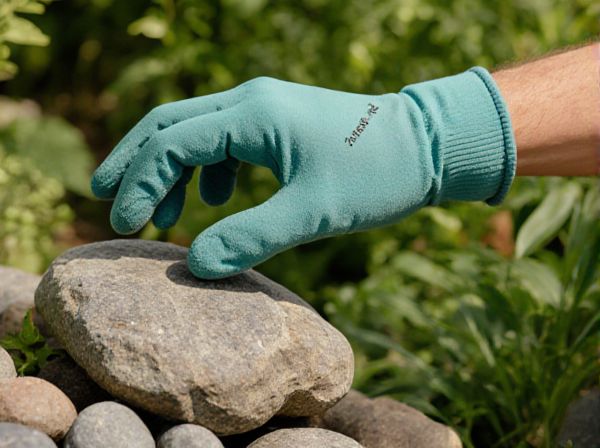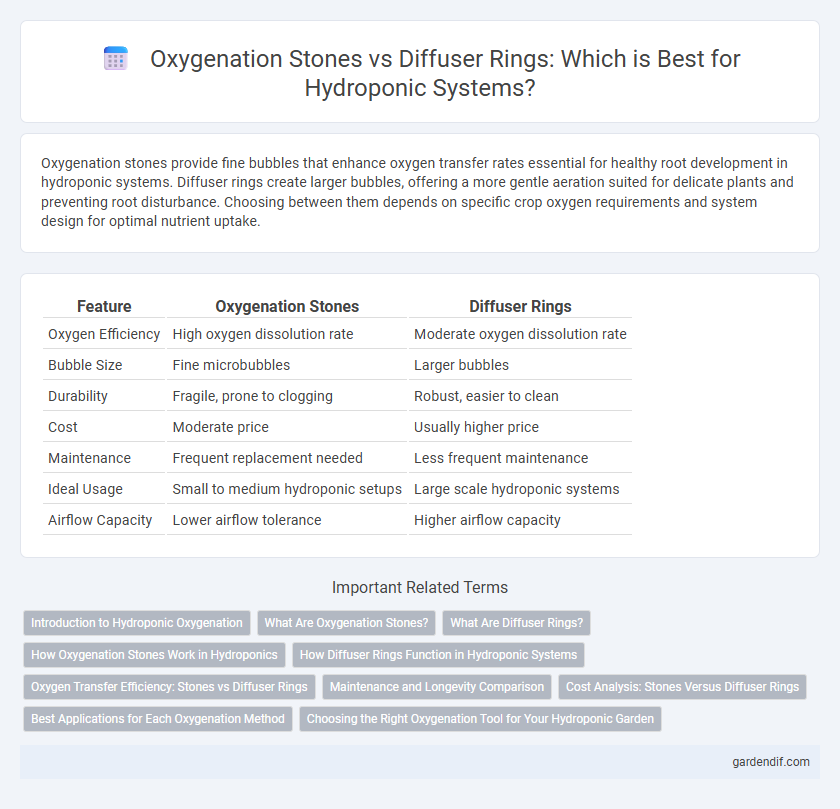
Oxygenation Stones vs Diffuser Rings Illustration
Oxygenation stones provide fine bubbles that enhance oxygen transfer rates essential for healthy root development in hydroponic systems. Diffuser rings create larger bubbles, offering a more gentle aeration suited for delicate plants and preventing root disturbance. Choosing between them depends on specific crop oxygen requirements and system design for optimal nutrient uptake.
Table of Comparison
| Feature | Oxygenation Stones | Diffuser Rings |
|---|---|---|
| Oxygen Efficiency | High oxygen dissolution rate | Moderate oxygen dissolution rate |
| Bubble Size | Fine microbubbles | Larger bubbles |
| Durability | Fragile, prone to clogging | Robust, easier to clean |
| Cost | Moderate price | Usually higher price |
| Maintenance | Frequent replacement needed | Less frequent maintenance |
| Ideal Usage | Small to medium hydroponic setups | Large scale hydroponic systems |
| Airflow Capacity | Lower airflow tolerance | Higher airflow capacity |
Introduction to Hydroponic Oxygenation
Hydroponic oxygenation is critical for plant root health, ensuring efficient nutrient uptake and preventing root rot. Oxygenation stones release fine bubbles directly into the nutrient solution, increasing dissolved oxygen levels rapidly and promoting aerobic conditions. Diffuser rings provide a gentler, broader distribution of oxygen bubbles, enhancing circulation and maintaining consistent oxygen levels throughout the hydroponic system.
What Are Oxygenation Stones?
Oxygenation stones, commonly known as air stones, are porous devices used in hydroponic systems to aerate nutrient solutions by producing fine bubbles, increasing dissolved oxygen levels essential for root health. Made from materials such as ceramic or bonded glass, these stones facilitate efficient gas exchange that promotes nutrient uptake and prevents anaerobic conditions. Compared to diffuser rings, oxygenation stones typically generate smaller bubbles, enhancing oxygen distribution and improving overall plant growth in hydroponic environments.
What Are Diffuser Rings?
Diffuser rings are circular aeration devices used in hydroponic systems to release oxygen evenly throughout the nutrient solution. These rings feature multiple tiny perforations that produce fine bubbles, enhancing dissolved oxygen levels critical for root health and nutrient uptake. Compared to oxygenation stones, diffuser rings offer broader coverage and reduced clogging, promoting more efficient oxygen distribution in hydroponic reservoirs.
How Oxygenation Stones Work in Hydroponics
Oxygenation stones in hydroponics operate by releasing fine bubbles into the nutrient solution, increasing dissolved oxygen levels essential for root respiration and nutrient uptake. These porous stones create microbubbles that enhance aeration, preventing root suffocation and promoting healthy plant growth. Their efficiency in oxygen transfer makes them a pivotal component in maintaining optimal hydroponic system performance.
How Diffuser Rings Function in Hydroponic Systems
Diffuser rings function in hydroponic systems by releasing fine oxygen bubbles uniformly throughout the nutrient solution, enhancing root oxygenation and nutrient absorption. These rings create a consistent airflow that supports beneficial microbial activity and prevents stagnant water zones, promoting healthier plant growth. Compared to oxygenation stones, diffuser rings provide more even dispersion of oxygen, reducing the risk of clogging and maintenance requirements in hydroponic setups.
Oxygen Transfer Efficiency: Stones vs Diffuser Rings
Oxygen transfer efficiency in hydroponic systems varies significantly between oxygenation stones and diffuser rings, with diffuser rings typically providing finer bubbles that increase surface area for gas exchange and enhance oxygen dissolution in nutrient solutions. Oxygenation stones release coarser bubbles that rise quickly, resulting in lower oxygen transfer rates compared to diffuser rings, which maintain sustained oxygenation critical for healthy root development. Studies show diffuser rings can improve oxygen transfer efficiency by up to 20-30% over traditional stones, optimizing dissolved oxygen levels for hydroponic crops.
Maintenance and Longevity Comparison
Oxygenation stones require frequent replacement every 6 to 12 months due to clogging from mineral buildup, while diffuser rings typically last longer, often several years, with minimal maintenance. Diffuser rings produce finer bubbles, reducing clogging and improving oxygen efficiency, which also lessens the need for cleaning. Proper regular maintenance such as soaking in vinegar extends the life of both, but diffuser rings maintain consistent performance over a longer period, making them more cost-effective for hydroponic oxygenation systems.
Cost Analysis: Stones Versus Diffuser Rings
Oxygenation stones generally present a lower upfront cost compared to diffuser rings, making them a budget-friendly option for small-scale hydroponic systems. Diffuser rings, though pricier initially, provide more efficient oxygen distribution and longer lifespan, potentially reducing replacement frequency and overall expenses. Evaluating cost-effectiveness should consider both the initial purchase price and the durability to optimize investment in hydroponic oxygenation equipment.
Best Applications for Each Oxygenation Method
Oxygenation stones are ideal for small to medium hydroponic systems requiring fine bubble delivery to maximize dissolved oxygen levels and enhance nutrient uptake in plant roots. Diffuser rings suit larger systems with higher flow rates, providing uniform oxygen distribution and improved water circulation for extensive root zones. Both methods optimize root zone aeration, but selection depends on system size, oxygen demand, and water flow dynamics in hydroponic setups.
Choosing the Right Oxygenation Tool for Your Hydroponic Garden
Oxygenation stones provide fine bubbles that increase dissolved oxygen levels quickly, enhancing root respiration and nutrient absorption in hydroponic systems. Diffuser rings create larger bubbles with a broader surface area, promoting gentle circulation and preventing stagnant water zones, ideal for larger grow trays and reservoirs. Selecting the right oxygenation tool depends on system size, plant types, and airflow requirements to optimize root health and overall hydroponic yield.
Oxygenation Stones vs Diffuser Rings Infographic

 gardendif.com
gardendif.com